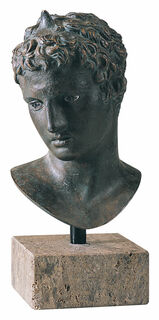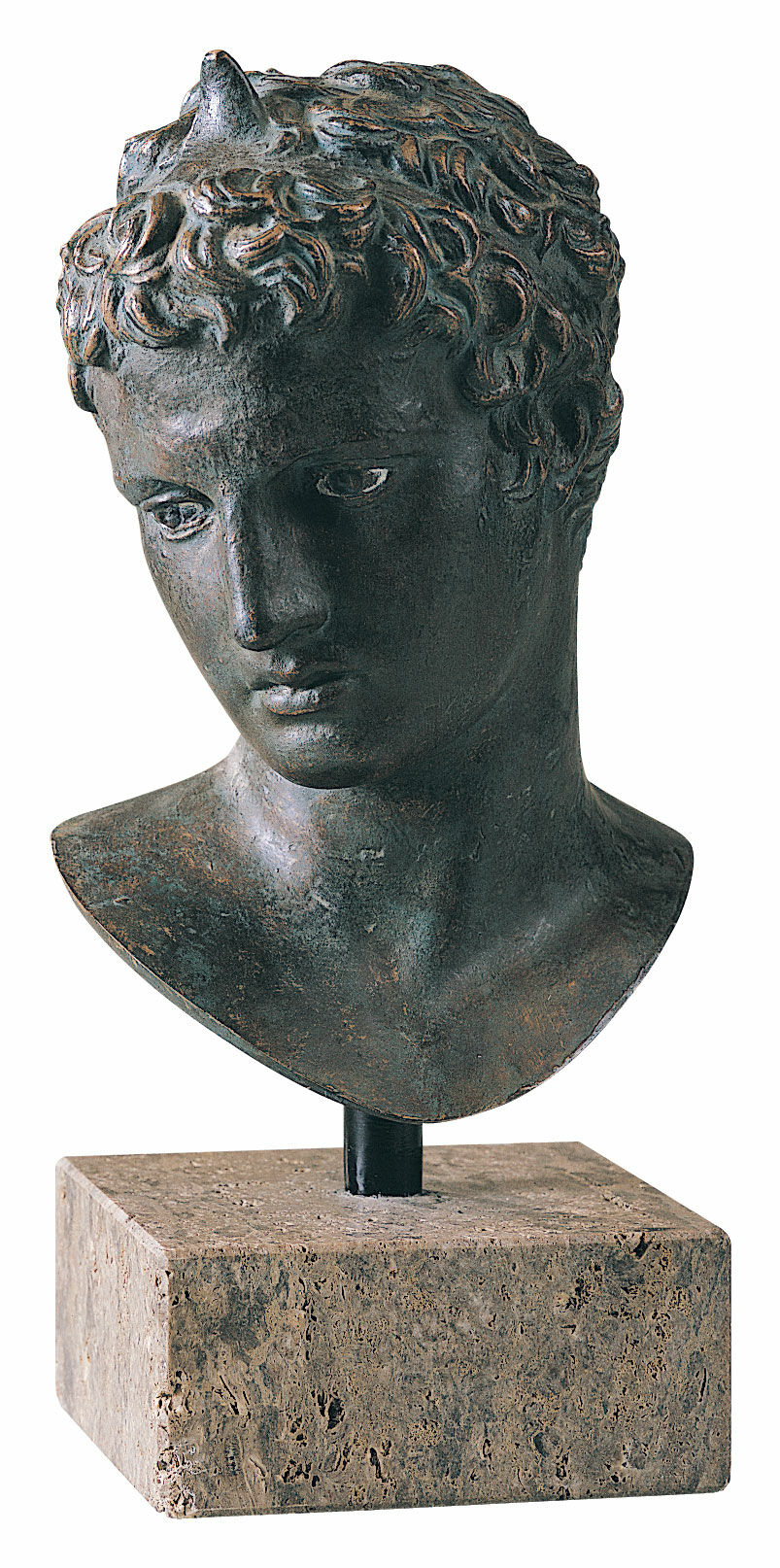Ephebe of Marathon Head, bonded bronze
Ephebe of Marathon Head, bonded bronze
Quick info
replica | bonded bronze + marble | total height 36 cm
Detailed description
Ephebe of Marathon Head, bonded bronze
With the triumvirate of Skopas, Praxiteles and Lysipp, the "Beautiful Style" of the Greek Late Classical period was born. Praxiteles avoided anything heroic or gigantic in his sculptures; even his virtuously sculpted gods appear in an amiable, human form. His famous originals, such as the "Aphrodite of Knidos", the "Hermes of Olympia", the "Lizard Killer", and the "Pouring Satyr", have been irretrievably lost - but Roman replicas still bear witness to them. But a unique find shook the art world: Greek fishers recovered a youthful statue of incomparable beauty near Marathon, which can be attributed almost beyond doubt to Praxiteles. It is probably Hermes who enraptures posterity and includes us in the blissful silence of his Elysian existence.
Original: Athens National Archaeological Museum. Praxiteles, Attic, c. 330 BC.
Bonded bronze. Height with marble pedestal 36 cm.
Customer reviews
sehr zufrieden. Danke
About Praxiteles
Praxiteles (c. 395 BC to c. 320 BC) was a Greek sculptor in Athens in the 4th century. He is praised by Pliny for his art of carving marble. However, his works in bronze are also known. Contrary to today's idea that the noble effect of marble is only caused by the white stone, Praxiteles had his sculptures painted by the painter Nikias. Through written records, in which his works are described, over fifty works are known to us today. These sculptures would be lost if the Romans had not made replicas.
Praxiteles' subjects were the gods of Olympus, whom he depicted as eternally youthful. In addition, portrait and funerary statues testify to the popularity of the Attic sculptor among his contemporaries.
His most famous statue and, according to Pliny, the most beautiful "in the whole world" is the "Aphrodite of Cnidus". Fifty large-scale Roman replicas of the beautiful woman undressing for her bath have been preserved. In addition to other images of Aphrodite, Praxiteles also created Eros statues, whose nudity gave rise to numerous scandalous anecdotes. One of his most famous statues of youth is the "Apollo Sauroktonos", which has been preserved in twenty Roman replicas. The most successful of these can be admired in the Louvre in Paris and the Vatican.
The sculptor always succeeded in lending grace to his statues by means of a beautifully curved contour. Especially in his images of the gods, he attached more importance to a differentiated depiction of the soul's feelings than to the reproduction of the sublime character typical of the time, thus giving them a human appearance.
Sculptural representation of person's head and shoulders.
Minoan art, Mycenean art
The Cretan art is also named Minoan art, after the legendary King Minos.
Cretan-Minoan art is the art of Crete from about 2900 - 1600 B.C., the Mycenaean art of Crete and the Greek mainland is dated from about 1600 - 1100 B.C., on Crete only to 1200 B.C.
German archaeologist Heinrich Schliemann discovered significant evidence of this culture in the shaft graves of Mycenae, which had its heyday in the 14th and 13th centuries B.C. A well-preserved testimony is the Lion Gate from the 13th century B.C.
Splendidly decorated vases are the artworks of ceramics that have best survived the turmoil of millennia. The Snake Goddess (around 1500 B.C.), a faience figurine, that has been discovered in the Repositories Temple of the Knossos palace are also famous. Bronze vessels of that time were primarily used in the household. Daggers, swords and armour were also made of bronze.
The jewellery of the Cretan-Mycenaean ladies was made of gold, rock crystal, lapis lazuli, ivory, faience and glass.
Geometric art
The geometric art developed as a continuation of the late Mycenaean art on the Greek mainland towards the end of the late 11th century B.C. Mathematically regulatory will of style entered the geometric art replacing the natural Crete-Mycenaean formal language. Another new feature was the use of the ruler and the compass. The jewellry of this time is also based on strict geometric principles.
Archaic art
The art of building developed on the temples developed in the 8th and 7th century B.C. Initially, mudbrick and wood were used for building, later the forms were transferred to stone. A monumental style developed in sculpture. Marble, bronze, clay and limestone were used as materials. Gods, heroes, victorious competitors were embodied in typical young nude statues. However, gods or other consecration figures were portrayed in clothes.
In addition to freestanding sculptures, relief art developed, which was preferably used for decoration of temples.
Statuettes made of clay and bronze first appeared in the 6th century B.C. They depicted humans, animals and mystical beings and are of high quality.
Classical art (5th and 4th century B.C.)
The beginning of the Greek Classical period coincides with the time of the great statesman Pericles. Because of his democratic politics, Athens became the centre of cultural life and artistic creation in ancient Greece.
The classic architecture refined the shapes and proportions to perfection. The Temple of Zeus at Olympia, the Parthenon on the Acropolis of Athens and other major temple buildings were built in that time.
In the field of sculpture, the time of the Severe style began. The rigid forms of the earlier period were outdated, the human body was studied anatomically. Top works of the Severe style include the Charioteer of Delphi and the Artemision Bronze, which was recovered from the sea by fishermen.
A further increase brought the High Classical sculpture. Sculptors like Myron, Phidias and Polykleitos created sculptures that affect the statuary art to the present day (e.g. "Discobolus ", "Athena-Marsyas group" and "Riace bronzes" etc.)
In the 4th century, a romantic conception prevailed. Praxiteles and Lysippos determined the art of the time. Sculptures such as "Hermes and the Infant Dionysus", "Pouring Satyr" and especially the "Aphrodite of Knidos" are magnificent examples of the artistic conception of Classical Greece.
Hellenistic art
With Alexander the Great's campaigns of conquest, the Greek art dominated the Mediterranean and the Orient. In the temple construction, the Ionic and Corinthian style prevailed.
Lysippos initiated the sculptural art of the Hellenistic period. The temple complexes, such as the one in Pergamon, were richly decorated with statues. The "Winged Victory of Samothrace" was created at the beginning of the 2nd century B.C. and the "Venus de Milo" – towards the end of the century. The era of Hellenistic sculpture reached a final climax with "Laocoön Group". The Painting of that period was determined by Apelles. The Hellenistic painters depicted themes like historical events, portraits and genre paintings.
Bronze powder is polymer-bonded. Special polishing and patination techniques give the surface of the casting an appearance similar to the bronze.
A true-to-the-original reproduction of an artwork in the same size and with the best possible material and colour uniformity.
The mould is usually taken directly from the original so that the replication reproduces even the finest details. After casting the replication, using the most appropriate method, the surface is polished, patinated, gilded or painted according to the original.
A replication of ars mundi is a recognizable copy of the original.
A plastic work of sculptural art made of wood, stone, ivory, bronze or other metals.
While sculptures from wood, ivory or stone are made directly from the block of material, in bronze casting a working model is prepared at first. Usually, it is made of clay or other easily mouldable materials.
The prime time of sculpture after the Greek and Roman antiquity was the Renaissance. Impressionism gave a new impulse to the sculptural arts. Contemporary artists such as Jorg Immendorf, Andora, and Markus Lupertz also enriched sculptures with outstanding works.


